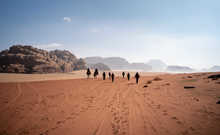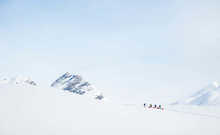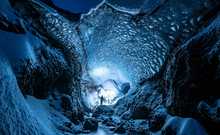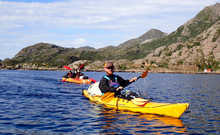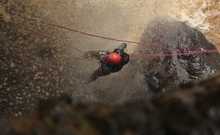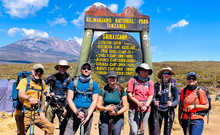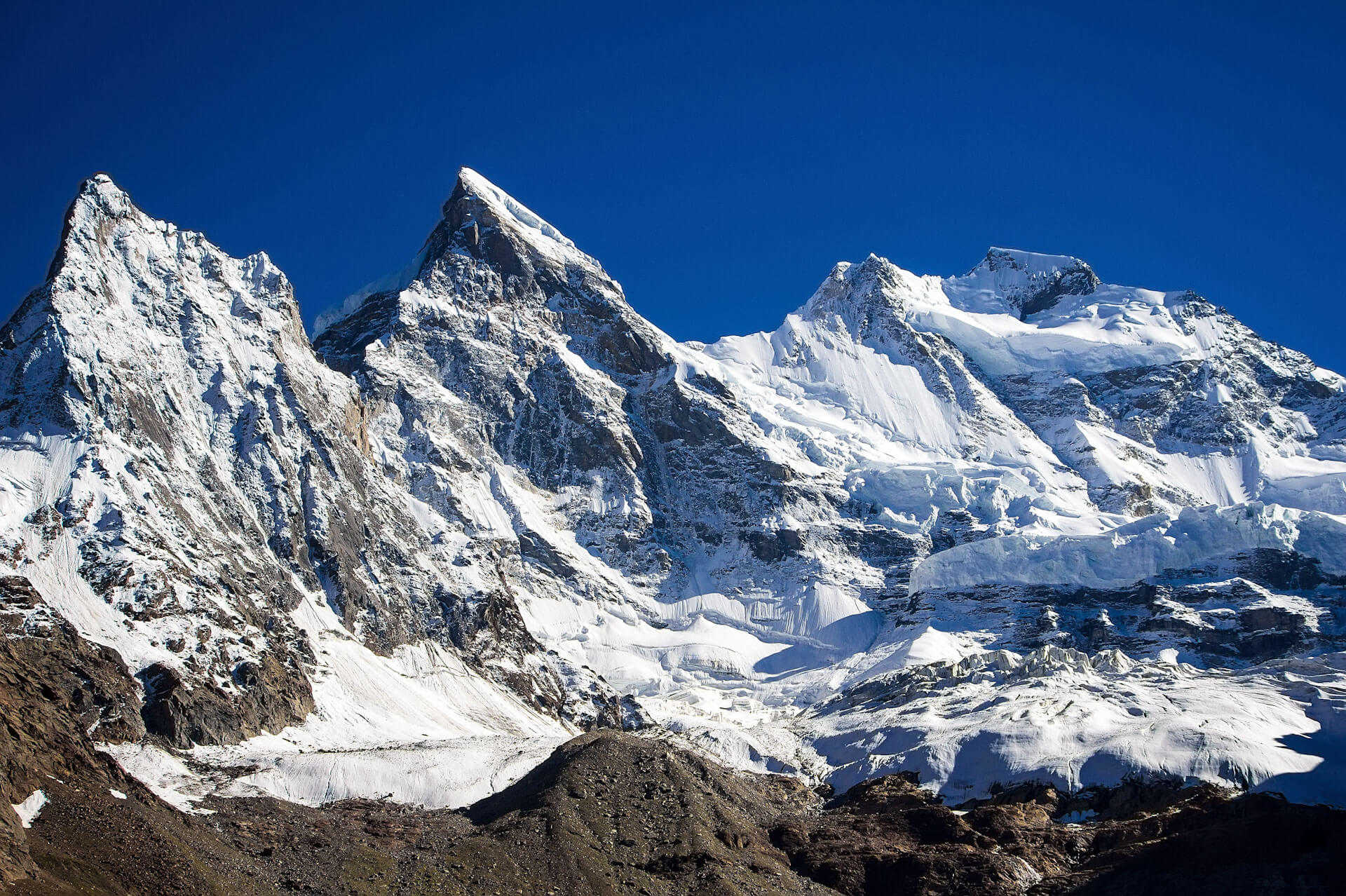←back to Ladakh Trekking Guide
Of course when trekking in Ladakh, altitude and air pressure tolerance varies widely from person to person. People who are more fit tend to have less trouble with AMS. However, even very fit people are vulnerable to AMS if they trek too high in too short a time, or without acclimatising properly.
AMS hits some people at altitudes as low as 2,400 metres (8,000 feet), but serious symptoms are quite rare below 3,700 metres (12,000 feet). It is the lack of oxygen, coupled with physical exertion that most often triggers AMS.
At 5000 metres the air pressure (and the amount of oxygen available to you with each breath) is only 55% of that at sea level. At 6000 metres it is less than half. This has a major impact on the body's physiology. AMS is not always a gradual worsening of the kinds of mild altitude related symptoms most people experience, including headache and shortness of breath. It can have a rapid, severe onset and can completely disable a trekker in minutes.
AMS has three primary components
Drop in oxygen saturation
Each breath you take at high altitude will deliver less oxygen to your blood, while increased physical activity will only increase oxygen demand. Slight reductions in the oxygen saturation in your blood will lead to feelings of fatigue and breathlessness. Larger drops in blood oxygen levels can cause impaired mental function and have other dangerous effects.
Any drop below 80% is considered very serious. If your blood oxygen saturation ever drops below 75% you will have to begin your descent immediately.
Cerebral Oedema (HACE)
Reduced air pressure can also cause body fluids to seep into your skull, or even into the fluid that protects your brain. At low levels, this results in mild headache. If it advances, it can put excessive pressure on the brain itself. If this occurs it can result in severe disorientation, coma or death. The onset (and development of the most serious symptoms) can be extremely fast.
Pulmonary Oedema (HAPE)
In the same way, the lack of pressure in the air can cause fluid to seep into your lungs. This can lead to pneumonia-like symptoms, and can be very dangerous if it occurs during sleep.
High Altitude Pulmonary Oedema can occur without any other symptoms of AMS, and can be serious on its own.
Protecting yourself from AMS
Our guides monitor all of our trekkers closely. They are all highly experienced in working at altitude, and know how to look after our trekkers. It is vitally important that you share information about your health and any symptoms you may be experiencing fully and openly. Failing to do so puts not only yourself at risk, but your fellow trekkers as well.
Recognising the Symptoms of AMS
- Vomiting, nausea or loss of appetite
- Weakness or fatigue
- Feeling light-headed or dizzy
- Difficulty sleeping
- Numbness, pins and needles
- Shortness of breath
- Rapid pulse (especially if persistent)
- Sleepiness or drowsiness
- Overall malaise
- Swelling or oedema of face or extremities
Symptoms Common to High Altitude Cerebral Oedema (HACE)
- Disorientation or confusion
- Unusual behaviour
- Fatigue
- Difficulty speaking or walking
- Nausea or vomiting
- Hallucination or vision problems
Symptoms Common to High Altitude Pulmonary Oedema (HAPE)
- Extreme fatigue and trouble walking
- Tight or congested feeling in the chest
- Productive cough, with or without blood
- Gurgling or crackling sound whilst breathing
- Shortness of breath, especially during rest
- High pulse at rest (90 to 100 bpm)
- Excessive sweating or fever
- Blue or grey lips and/or fingernails
No matter what symptoms of AMS you experience, the treatment is the same: descending at least 1000m immediately, until symptoms abate.
Kandoo’s Emergency Descent Protocol
If your guides have concerns about your health, or believe that continuing the trek would be dangerous for you, they will insist that you begin your descent immediately. This decision will be made to make sure that you remain safe, while maximising your chances of a successful trek. If you are only displaying mild symptoms your condition will be monitored at regular intervals by the guide. Please notify them immediately if your condition worsens, even slightly. The guide is given full responsibility to decide if you need to descend and their decision is final.
Avoiding AMS Altogether
‘Walk High, Sleep Low’
We make every effort to give you the opportunity to do a short walk at a higher altitude every day, rest there for approximately 30 minutes, then descend again to sleep.
Go slowly!
You need to maintain a breathing rate low enough that you could easily maintain a conversation. If you find you are breathing hard, slow down. Overworking your heart and lungs puts you at much higher risk of AMS.
Drink more than you feel you need to
Proper hydration not only makes AMS less likely, it makes you less vulnerable to a host of other problems as well. To protect yourself, you need to drink at least 3 litres of water each day, especially if you don’t feel thirsty. If your urine is yellow (or worse, orange) you are not drinking nearly enough.
Dehydration can be mistaken for HACE, and cause you to be taken back down the mountain, so drink up!
Diamox
A great deal of research has been done on Diamox, and its effectiveness in protecting against AMS. (Just google ‘Diamox’.) Our UK team use it, but it is a prescription drug, and some GPs do not advocate its use. As with any medicine, you should seek professional advice.
It is important to remember that Diamox is a preventative medicine, it helps with speeding up the acclimatisation process, but is not a cure for AMS.
If Diamox is to be used effectively, it must be taken before you start to trek. It will be of no help at all after you begin experiencing symptoms. Various sources recommend between 125 mg and 500 mg per day, beginning a few days before you move up to a higher altitude. We personally recommend ½ of a 250mg tablet in the morning, and the other at night, especially for anyone planning on ascending up to 3000 metres in one day.
Trekkers who do take Diamox report side effects including pins and needles or numbness in their fingers and toes. It also makes you want to urinate more frequently. Combined with the 3 litres of water you’ll be drinking each day, you’ll need an extra jug. Interestingly, it also makes all fizzy drinks, including beer, taste terrible.
Our altitude information and emergency descent protocols are
periodically reviewed by a medical professional specialising in high altitude.
This was most recently completed in October 2024.
←back to Ladakh Trekking Guide
